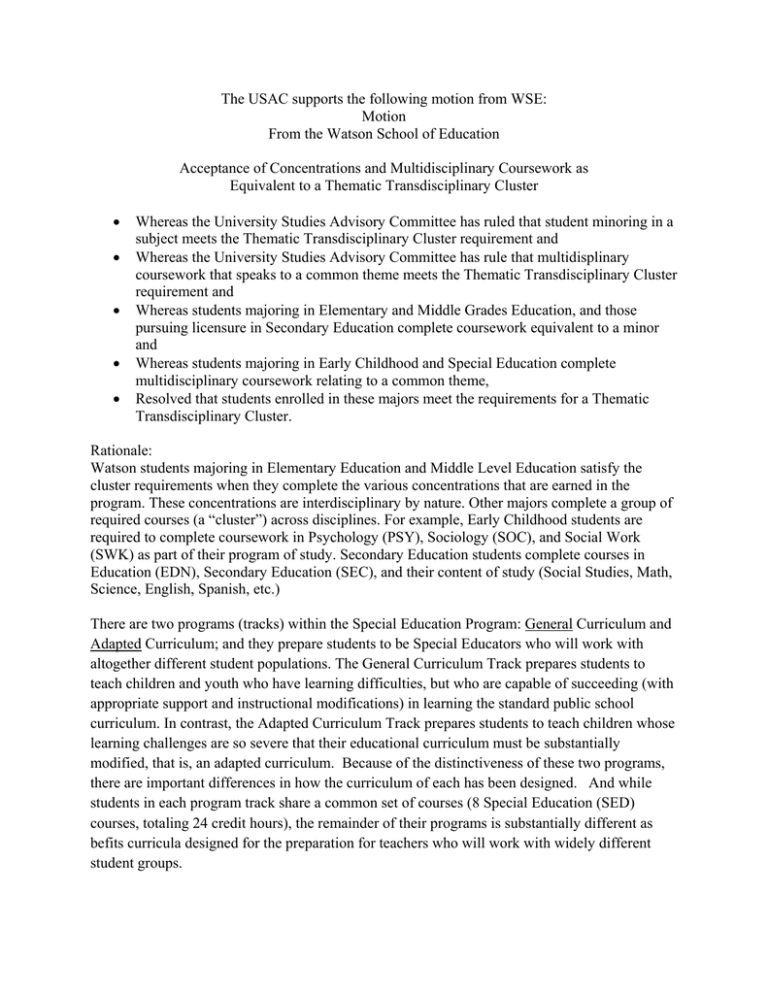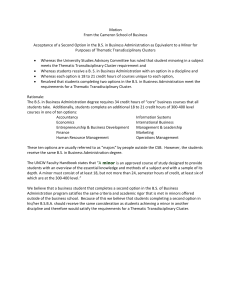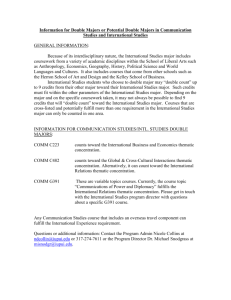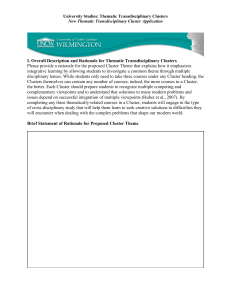The USAC supports the following motion from WSE: Motion
advertisement

The USAC supports the following motion from WSE: Motion From the Watson School of Education Acceptance of Concentrations and Multidisciplinary Coursework as Equivalent to a Thematic Transdisciplinary Cluster Whereas the University Studies Advisory Committee has ruled that student minoring in a subject meets the Thematic Transdisciplinary Cluster requirement and Whereas the University Studies Advisory Committee has rule that multidisplinary coursework that speaks to a common theme meets the Thematic Transdisciplinary Cluster requirement and Whereas students majoring in Elementary and Middle Grades Education, and those pursuing licensure in Secondary Education complete coursework equivalent to a minor and Whereas students majoring in Early Childhood and Special Education complete multidisciplinary coursework relating to a common theme, Resolved that students enrolled in these majors meet the requirements for a Thematic Transdisciplinary Cluster. Rationale: Watson students majoring in Elementary Education and Middle Level Education satisfy the cluster requirements when they complete the various concentrations that are earned in the program. These concentrations are interdisciplinary by nature. Other majors complete a group of required courses (a “cluster”) across disciplines. For example, Early Childhood students are required to complete coursework in Psychology (PSY), Sociology (SOC), and Social Work (SWK) as part of their program of study. Secondary Education students complete courses in Education (EDN), Secondary Education (SEC), and their content of study (Social Studies, Math, Science, English, Spanish, etc.) There are two programs (tracks) within the Special Education Program: General Curriculum and Adapted Curriculum; and they prepare students to be Special Educators who will work with altogether different student populations. The General Curriculum Track prepares students to teach children and youth who have learning difficulties, but who are capable of succeeding (with appropriate support and instructional modifications) in learning the standard public school curriculum. In contrast, the Adapted Curriculum Track prepares students to teach children whose learning challenges are so severe that their educational curriculum must be substantially modified, that is, an adapted curriculum. Because of the distinctiveness of these two programs, there are important differences in how the curriculum of each has been designed. And while students in each program track share a common set of courses (8 Special Education (SED) courses, totaling 24 credit hours), the remainder of their programs is substantially different as befits curricula designed for the preparation for teachers who will work with widely different student groups.

![[This document is the ‘external package’ that all transfer students... UNCW’s website.]](http://s2.studylib.net/store/data/012060373_1-e251e5009bb411000b0497268222e4e3-300x300.png)

